Written by Robert Wu for his family and friends
—————————————————————————-
As a Cantonese person 廣東人, I always knew my spoken Chinese is different from that spoken in the rest of China. This distinction made me interested in my heritage and the local history of GuangDong 廣東 within the larger history of China.
The following is the result of my quest to find my Cantonese 廣東 roots. This brief history may be somewhat tedious, and you may not want to dive into it. But if you are interested in Chinese history, you may find it interesting.
The Ethnic Groups of Ancient China
Ancient China 5,000 years ago was composed of major ethnic groups. There was the Hua Xia 華夏 group around the Yellow River 黄河 in the north; the Miao 苗 group around YangTze 長江 River in central China; The Bai Yue 百越 group along the southern coast; the Dong Yi 東夷 group along the northern coast; and various nomadic tribe in the northern grasslands.
Hua Xia 華夏 group claims to be descendants of legendary Yellow Emperor 黄帝. Dong Yi 東夷, Miao 苗 and Bai yue 百越 groups all claimed to be descendants of legendary Chi You 蚩尤 who lost an epic war to Yellow Emperor 黄帝. Of the three legendary sage kings venerated by all Chinese, Yao 堯 was a Hua Xia 華夏 person; Shun 舜 was a Dong Yi 東夷 person; and Yu 禹 was a Bai Yue 百越 person.
Of China’s earliest dynasties, Bai Yue’s 百越 Yu 禹 formed the first, Xia 夏, dynasty. The second Shang 商 dynasty was formed by Dong Yi 東夷 people. The third Zhou 周 dynasty was formed by Hua Xia 華夏 people. Ancient China was obviously an equal opportunity kingdom.
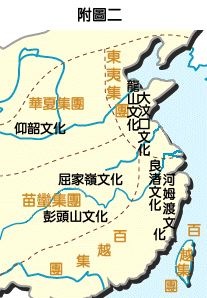
(from web)
Han 漢 people make up 92% of China’s population today, the other 55 minorities make up 8%. These 56 ethnic groups are called nationalities in today’s China. The following web site gives details on them:
http://big5.xinhuanet.com/gate/big5/news.xinhuanet.com/ziliao/2003-01/21/content_700050.htm
What Happened to the Ancient Tribes?
Of these groups, the Hua Xia 華夏 group developed first and became the most advanced Han 漢 civilization. The Hua Xia 華夏 people expanded, conquered and were sometimes conquered, assimilated, and absorbed the cultures and gene pools of all the other groups. This conglomeration of cultures became today’s Han 漢 Chinese people who are all considered descendants of Yellow Emperor 黄帝子孫. Hence the Yellow River 黄河 basin is credited as the cradle of the Chinese civilization.
In this amalgamation, the Dong Yi 東夷 group was absorbed and that land produced Confucius 孔夫子. The Miao 苗 group was sinicized, its land became the rice bowl of China and produced Lao Zi 老子 of Taoism 道教. Nomadic tribes from the North and Northwest raided China proper and caused great deals of headache, but they were eventually absorbed into the Han 漢 gene pool. The southern Bai Yue 百越 was conquered 2,000 years ago and the mixture of Han 漢 and Yue 越 cultures produced a patchwork of different results.
The Vanishing Miao 苗 Group
The ancient Miao 苗 tribes spoke Miao-Yao 苗瑶 languages. Three thousand years ago in the Yangtze River 長江 basin, Miao 苗 tribes fought vigorously against Hua Xia 華夏, eventually mixed with Han 漢 culture and established the powerful kingdom of Chu 楚國. Most of the ancient Miao 苗 people have been sinicized and become the Han people 漢人 of central China provinces. Small groups preferred independence and migrated into the mountains as the scattered Miao 苗族 and Yao 瑶族 nationalities in Southwestern China, totaling 10 million people, and the Hmong and Mien tribes of Southeast Asia today.
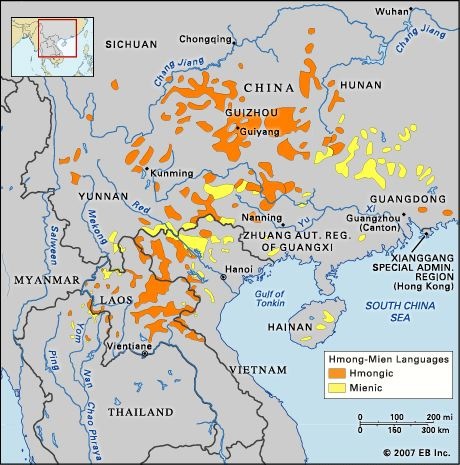 (from web)
(from web)
Miao 苗 women in their elaborately embroidered dresses and flamboyant silver jewelries.
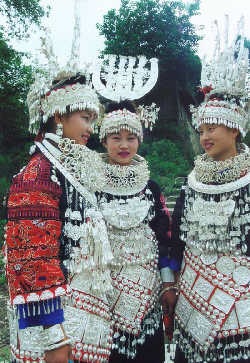
(from web)
The Hundred Yue Tribes 百越
Bai Yue 百越 was the encompassing name given to many ancient tribes that lived along the southern coast. There were no detailed records of their individual ethnicity or language. They included the following tribes:
Gou Wu 句吳 became the kingdom of Wu 吳國 around today’s SuZhou 蘇州,
Yu Yue 於越 became the kingdom of Yue 越國 in today’s ZheJiang 淅江 province,
Yang Yue 揚越, Yangtze Yue lived around today’s Nanjing 南京,
Min Yue 閩越 of FuJian 福建 province,
Nan Yue 南越, Southern Yue of GuangDong 廣東 province,
Dong Yue 東越, Eastern Yue,
Shan Yue 山越, Mountain Yue,
Shui Yue 水越, Water Yue,
Luo Yue 雒越 of today’s GuangXi 廣西,
Ou Yue 甌越 of Vietnam.
The ancient Yue 越 people shared some common traits. They lived in stilted houses, cut their hair short, bared feet, tattooed their bodies, ate snakes, grew rice, had frogs as their totem, held the bronze drum as sacred symbols of state, were skillful metallurgists who made sharp swords, and were good seamen. It is speculated they sailed the seas millennia ago and populated the Pacific Islands of Philippines, Indonesia and Polynesia.
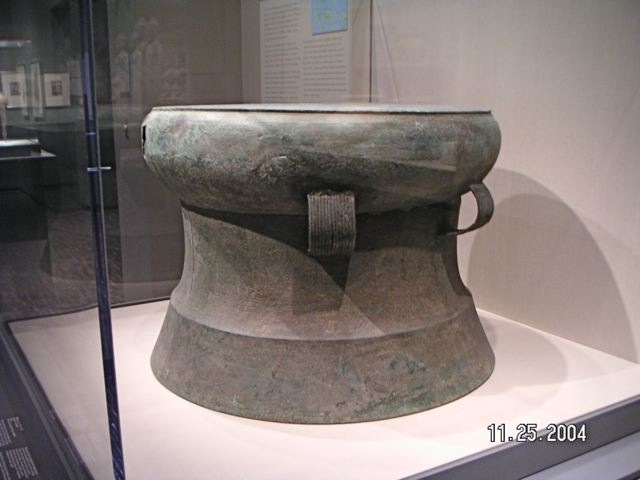
(from web)
The Transformation of Bai Yue 百越
The Bai Yue 百越 tribes were conquered by 500,000 troops of the First Emperor of Qin 秦始皇 2,200 years ago. With increasing number of Han 漢 people moving into Bai Yue 百越 lands as soldiers, migrants, exiles, or refugees, Han 漢 culture began to dominate. Han 漢 people had greater cultural, economic and political powers, driving many Yue 越 people into the hills. The Yues 越人 who remained in lowlands assimilated to the Han 漢 culture, resulting in new dialects of the Chinese language: the Wu 吳語, Cantonese 粵語, and Fujianese 閩語 spoken languages.
The following map of Chinese spoken language distribution today shows the homogeneity of PuTongHua 普通話 in most of China, but a heterogeneity of many dialects in the old Bai Yue 百越 areas along the coast. While people speaking different dialects may be mutually unintelligible, they share the same written language. Written Chinese is not phonetic and a character means the same even if read with different sounds. If people cannot understand one another’s spoken Chinese, they can communicate in writing.
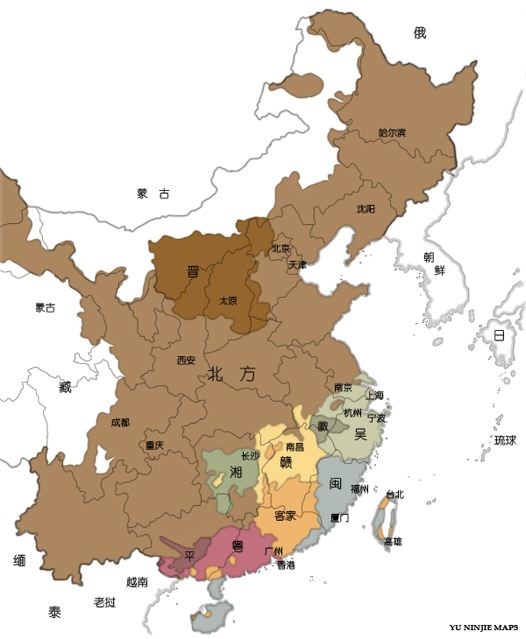
(from web)
Shortly after the Bai Yue 百越 tribes were conquered, they yearned independence. A Nan Yue kingdom 南越國, incorporating what is Vietnam today, arose in today’s GuangDong 廣東; and a Min Yue kingdom 閩越國 arose in today’s FuJian 福建. They lasted about a hundred years before they were absorbed by the Han dynasty 漢朝.

(from web)
Descendants of Bai Yue 百越
In the last 2,000 years, most of the Bai Yue 百越 people have mixed their gene pools with the other groups of China. Nan Yue 南越 has sinicized as the Cantonese people 廣東人; MinYue 閩越 have sinicized as the FuJian people 福建; and Gou Wu 句吳, Yu Yue 於越 and Yang Yue 揚越 all have sinicized around the Yangtze River; and today they all call themselves Han 漢 people.
But some tribes resisted assimilation and sought independence from Han 漢 domination. Substantial number of the Zhuang-Dong 壯侗 (Tai-Kadai) language tribes migrated a thousand years ago to today’s Thailand and became the Thai people, and to today’s Laos and became the lowland Laotian people. Other non-sinicized Zhuang-Dong 壯侗 language tribes scattered in southwestern China and are today’s Zhuang 壯族, Dong 侗族, Dai 傣族, Shui 水族, Gelao 仡佬族, Li 黎族, and Pu Yi 布依族 nationalities of China. Unlike the Vietnamese, Thai, and Laotians, these tribes did not develop political cohesiveness to form independent nations.
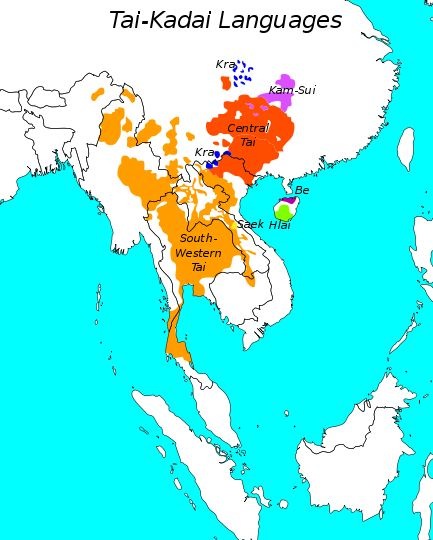
(from web)
The Vietnamese language of Ou-Luo Yue 甌雒越 (Au Lac in Vietnamese) has been identified as one of the Austro-Asiatic languages that include Cambodian and some highland tribes. Today, Ou-Luo Yue 甌雒越 retained its independence and the Vietnamese is a non-Han people.
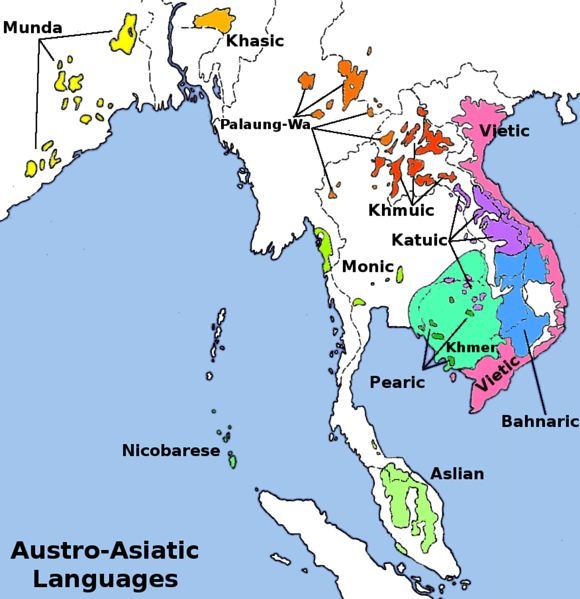
(from web)
Looking Ahead
The legacies of these Bai Yue 百越 tribes are fading, and the tribes are losing their identities to urbanization of China. One taxi driver in GuangXi 廣西 told me he was a Zhuang 壯 person, but he lived in the city all his life and he could not speak the Zhuang 壯 language.
As in the US where locality names such as Dakota are leftover native American names, Bai Yue 百越 legacies also exist as occasional leftover place names even after the ancient tribes are long gone. For example, in Hong Kong, Wo Che 和輋 means Wo Planting Hillside and ShaLokTung 沙螺洞 means ShaLok Village in the ancient Li Liao 俚僚 language.
The study of the tribes of China is a continuing process to identify and categorize the many groups of people from ancient times to the present. As science advances, newer methods will be used and new findings will be discovered. Until then, this is the brief story of the southern tribes of China.
please tell me which emperors spoke Cantonese
or which group or tribe spoke it before the emperors unified china?
Neville,
The closest I can think of is the emperor of the Taiping rebellion in 1850 to 1864. Its leader, Hong XiuQuan (洪秀全) was a native of GuangXi province. Many people there speak Cantonese, the dialect of the adjacent province GuangDong.
Before the Qin unification of China in 221BC, the NanYue (南越) tribe located in today’s GuangDong Province likely spoke Cantonese. But that language underwent great changes after the unification and constant migration of people from northern China. So the Cantonese of today is a mixture of the aboriginal Yue language and the Chinese of China proper, and most likely different from the language of the NanYue people.
Bob
This is awesome. Thanks for taking the time to write this up. The maps are really helpful for me, too.
Thanks so much! I bless you in Jesus’ name.
dayn
Wonderful page.
First of all I would like to say great blog! I had a quick question that
I’d like to ask if you don’t mind. I was
interested to find out how you center yourself and clear your thoughts before writing.
I have had a tough time clearing my thoughts in
getting my thoughts out. I do take pleasure in writing but it just seems like the
first 10 to 15 minutes are usually lost simply just trying to figure out how to begin.
Any recommendations or hints? Appreciate it!
Thanks.
When I write, I imagine myself talking to a friend on a mutually interested topic. Frequently, it would be my observations of one aspect of a trip I took, but it could also be instigated by a current event. It should be a narrowly defined topic which can be covered in 5, 10 minutes.
I would organize my thoughts to form the outline of my talk; including introduction, interesting snippets, one outstanding point, and conclusion. I would collect all my photos relevant to this topic into one album in my computer. Looking through the photos in this album, I would select several for the blog, organizing them to fit into the outline of the story. When I don’t have relevant photos of my own, I would search the web to find needed ones. Finally, I look at each photo and write my narratives to accompany the photo; and the blog is finished.
I developed this method of writing on my own as I wrote my blogs. If it helps you in your writing, I would be happy.
This is a great page. Thank you very much, Mr. Wu. I am Filipino. As with a large percentage of my compatriots, i have Fujianese ancestry from my great great grandparents.
Thanks Roy. I am glad you find this article interesting and useful in tracing your ancestry.
Hi there,
It is great to find someone like you who is interested in the history of Bai Yue (and those of some other tribes).
I was born in Vietnam and I know exactly that I am 100% Vietnamese, I mean I belong to a group of people who claim themselves as Kinh/ Viet (Viet = Yue like in Vietnam = Viet Nam = Nan Yue).
As you can see, my family name is Hồ = Ho (in English) = Hu (if I were a Chinese) = Hú (like in Hú Jǐntāo = Hồ Cẩm Đào).
My family has at least 3 great kings/ politicians who went down in the history of Vietnam:
Hồ Quý Ly = First King of Ho Dynasty (1400-1407), invaded by Ming Dynasty.
Hồ Hán Thương = Second King
Hồ Nguyên Trừng = First Child of Hồ Quý Ly (WIKI: He’s considered to be an innovator of firearms. His famous inventions including early version of “Eruptor” cannon which later adopted by Ming dynasty and many decked war vessels. After the fall of Hồ dynasty, he was captured by the Ming emperor and forced to teach the Chinese how to cast cannons.)
Hồ Thơm = Nguyễn Huệ/ Quang Trung = The greatest general/ king of Vietnam, he won a lot of battles in his time and even once in the history of Vietnam almost forced Qianlong Emperor to give back Guangxi and Guangdong but he died young (maybe by the hands of Quianlong Emperor because of his fear of the talented general)
Hồ Chí Minh = President/ Uncle Ho = It is believed that the real father of his is Hồ Sĩ Tạo, instead of Nguyễn Sinh Sắc as Vietnamese propaganda has been promoting, but it is too sensitive to talk about it in Vietnam.
They are all from only one branch of Hồ Clan in Vietnam, descendant of an only ancestor Hồ Hưng Dật. See his biography below:
Thời Hậu Hán (947-950), có Trạng nguyên Hồ Hưng Dật được cử sang làm Thái thú ở Diễn Châu. Khi về nước, ông đã để người con thứ hai ở lại. Rồi người con này lại từ Diễn Châu dời đi ở Quỳnh Lưu.
First Doctoral Candidate Hồ Hưng Dật (of China) came to Vietnam around the year of 1000 or ealier (WIKI: He is from the Dynasty of Later Han (Five Dynasties) (947–951), a state in the Five Dynasties and Ten Kingdoms period.). Hồ Hưng Dật was promoted as a Chinese Governor and he left a second son back in Vietnam before coming back to China. The history of Hồ Clan started upwards.
The most interesting thing is that Hồ Hưng Dật is a Min Yue person and he came from Zhejiang, China. I know this fact and some relatives of mine have been checking the relations with other Hồ Clans in China today. However, from the bottom of my heart, I know my Min Yue share was dominated by Lou Yue and Ou Yue parts.
In Vietnam, Trần Dysnasty is very famous and their ancestor came from China as well. Some sources claim that they were from Min Yue people as well but some just say they were merely Bai Yue, no detailed information.
A lot of clans who are not as famous as ours also share roots from China, Bai Yue or Han, depending on which periods they moved to Vietnam and why. But, unfortunately, roots as you said are alwasy unclear enough for people to see the connection and it is, clearly, descendants are now calling themselves Viet people and somehow are not interested in the past. They know they are Viets and that’s all. I don’t like it and people who love history also agree with me.
It is about me and one day, if you still read these comments, I hope you will talk more about Cantonese people. I read some posts on China History Forum and some members denied their relations with Bai Yue roots, only saying that they are more Han than Yue. Sad to know that but I think things may get clearer one day with information from someone like you. Hope.